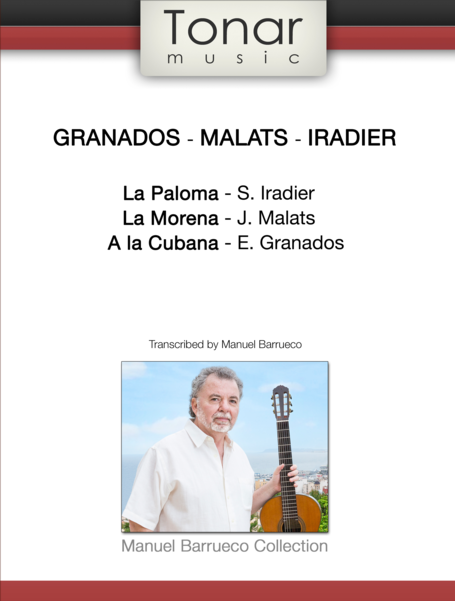
Granados Malats Iradier
| Sheet Music: | $14.95 | Add Sheet Music to Cart |
Description:
La Paloma by S. Iradier (Trans. M. Barrueco)
La Morena by J. Malats (Trans. M. Barrueco)
A La Cubana by E. Ganados (Trans. M. Barrueco)
La Paloma (The Dove) is one of the most beloved Spanish songs of all time, a song that went on to become famous all over the world. It was written by the Spanish composer Sebastián Iradier (1809-1865) after having visited Cuba around 1860. It is a habanera, a dance form from Havana, which was very popular at that time. Another habanera written by Iradier was El Arreglito (The Little Arrangement), which Georges Bizet, believing that it was a folk melody, would recompose to become the famous aria "L'amour est un oiseau rebelle" in his opera “Carmen.” When Bizet found out that the melody had in fact an author, he revised the score to recognize Iradier as the composer. In 1879, La Paloma was registered at the copyright office in Madrid as a "Canción Americana con Acompañamiento de Piano" (American Song with Piano Accompaniment). Iradier died in obscurity, never to see how popular La Paloma would become.
La Morena (The Dark-Skinned Woman) was written by the Spanish pianist and composer Joaquín Malats (1872-1912). Malats wrote mostly salon pieces for the piano. The tropical and sensual La Morena, which Malats characterizes as a cubana, is such an example. Another example is his most famous piece, Serenata Española, a piece that would also become a favorite among guitarists after Francisco Tárrega made his guitar transcription.
Malats was close friends with Issac Albéniz and Enrique Granados and a devoted proponent of their music. He performed many of their works frequently in concert, including the masterpieces Goyescas by Granados and the monumental Iberia by Albéniz. The Valses Poéticos by Granados, a piece very popular among guitarists, was dedicated to Malats. The following quote from a letter Albéniz wrote to Malats in 1907 clearly demonstrates the extent of his admiration and affection for Malats:
“As you know, this work, this Iberia of my sins, is composed both for and because of you, and that the memory of the affectionate friend I have in you and, especially, the memory of the wonderful artist you are, have inspired these pages…”.
“Ya sabes que esta obra, esta Iberia de mis pecados, la escribo por ti y para ti, y que el recuerdo del cariñoso amigo que en ti tengo y sobre todo, el recuerdo del maravilloso artista que eres, han inspirado esas páginas…”.
A la Cubana, Op. 36 (In the Cuban Style) was written in 1914 by the great Spanish composer Enrique Granados (1867-1916). It is difficult to find a Spanish composer who lived around the turn of the twentieth century who did not compose at least one piece of music connected in some way to Cuba. Certainly, the three most important composers, Albéniz, Granados, and Falla, did. In the case of Granados, it may have influenced him that his father, a Spanish army captain, was actually born in Havana of Cuban parents. Also, judging from the musical contents of A la Cubana, it is not difficult to wonder if Granados may have been aware of Ignacio Cervantes’ music and that it influenced him as well. A la Cubana is a warm and lyrical piece in two movements. It is written in the form of a rondo, with its swaying, tropical opening theme continually returning after each new section of the piece.
Manuel Barrueco






